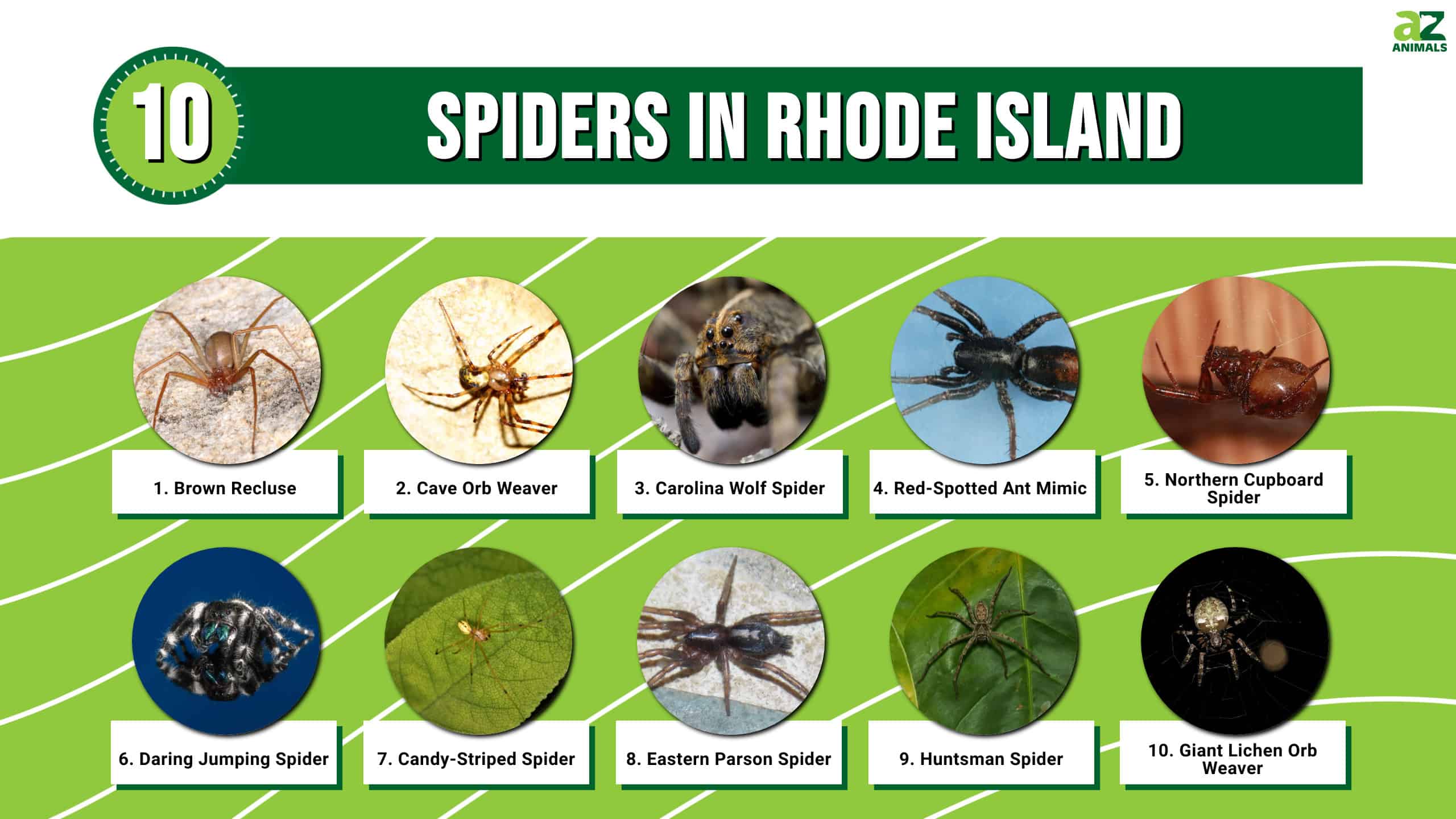
When most people think of Rhode Island, they think of “tiny.” After all, it is the smallest state in the United States. However, it’s not called The Ocean State for nothing, as it boasts nearly 400 miles of coastline and sandy beaches. There’s more to Rhode Island than meets the eye, evidenced by the many plants and animals found there, such as sea turtles and burrowing owls. Rhode Island is also home to spiders, ranging from tiny orb weavers to giant wolf spiders and huntsman spiders. Here is a list of 10 spiders in Rhode Island that you can find throughout The Ocean State.
#10. Giant Lichen Orb Weaver
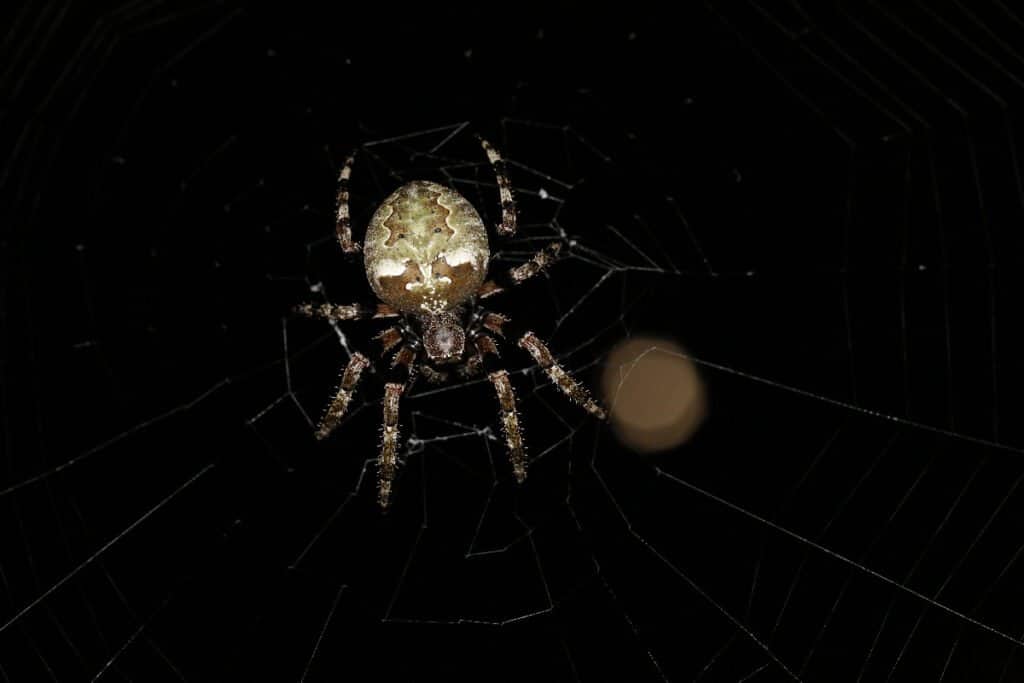
The giant lichen orb weaver creates webs nearly eight feet wide.
©Cathleen Wake Gorbatenko/Shutterstock.com
The giant lichen orb weaver, Araneus bicentenarius, is one of the most massive orb weaver spiders in Rhode Island. You can find it throughout most of the central and eastern United States along with parts of Canada.
Adult giant lichen orb weavers measure up to 24 millimeters long, although males typically measure smaller than females. The logs generally appear black with orange rings, while the body looks greyish-green with white and dark markings. That said, the colors can also look yellow. People sometimes confuse them with European garden spiders, but you can tell them apart because the giant lichen orb weaver lacks a cross-shaped marking.
In addition to their size, giant lichen orb weavers get their name from their vast webs that reach up to 8 feet in diameter. Despite their size, their bite is not medically significant, causing little more than some pain and redness.
#9. Huntsman Spider
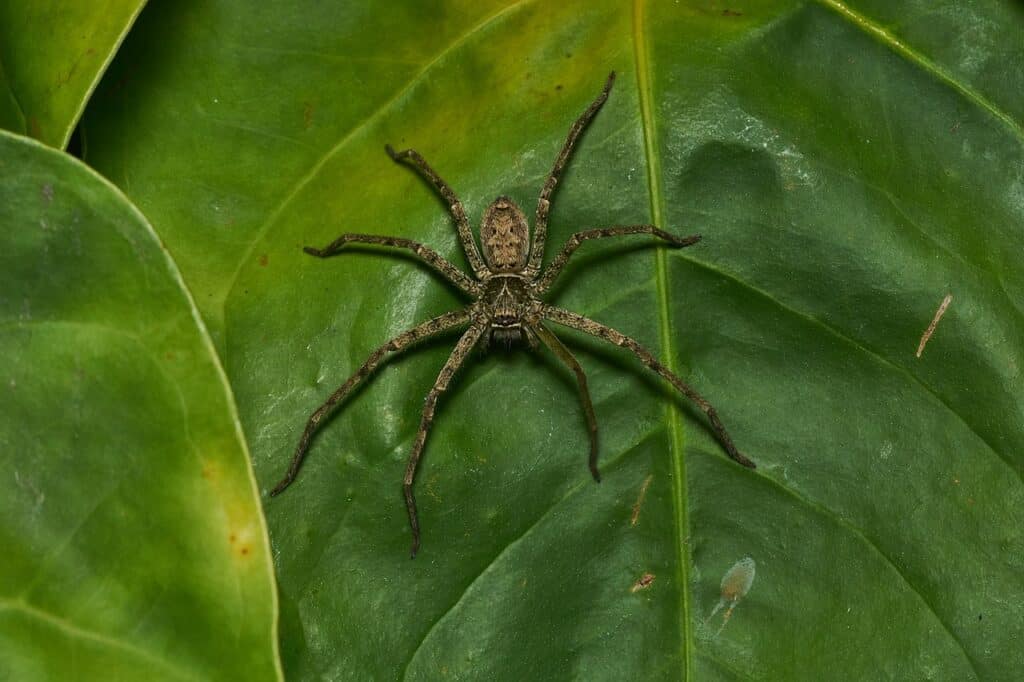
Pantropical huntsman spiders can measure nearly 12 centimeters long with their legs extended.
©© 2017 Jee & Rani Nature Photography / CC BY-SA 4.0 via Wikimedia Commons – License
Heteropoda venatoria, or the huntsman spider, is one of the largest spiders in Rhode Island. It goes by many other names including the cane spider and giant crab spider. A member of the family Sparassidae, you can find it in subtropical regions throughout the world.
Adult huntsman spiders range between 20 and 25 millimeters long, with females measuring a tad larger than males. That said, males usually have longer legs than females. They appear predominantly tan or light brown except for some dull black markings. Additionally, the space in front of their eyes looks cream or yellow, and they sport a creamish-tan band in the middle of the carapace.
Instead of using webs, huntsman spiders actively chase after and overpower their prey. In addition to insects, they will attack and eat larger animals such as scorpions and bats. While not medically significant, their bite can be quite painful.
#8. Eastern Parson Spider

The eastern parson spider features a marking that looks like an 18th-century parson’s necktie.
©Fyn Kynd from Searsmont, Maine, United States / CC BY 2.0, via Wikimedia Commons – License
Herpyllus ecclesiasticus is more commonly known as the eastern parson spider. A member of the ground spider family Gnaphosidae, you can find this spider in Rhode Island and throughout the eastern United States.
In general, adult eastern parson spiders measure from 10 to 20 millimeters long, with males measuring smaller than females. Their cephalothorax features a cove of fine black hairs. Meanwhile, grey hairs cover their abdomen. They feature a distinctive white mark shaped like a cravat (a necktie worn by 18th-century clergy or parsons), which is where they get their name.
During the day, eastern parson spiders hide in silken retreats under rocks and logs. They emerge at night to either ambush or actively chase down their prey. They can run very quickly, and while not dangerous, their bite is supposedly rather painful.
#7. Candy-Striped Spider

The common candy-striped spider has red stripes along its body that look like candy stripes.
©iStock.com/Ines Carrara
The common candy-striped spider, Enoplognatha ovata, belongs to the cobweb spider family Theridiidae. While originally native to Europe, you can also find this tiny spider in Rhode Island and throughout the United States and Canada.
Adult females usually measure around 6 millimeters long, while males measure slightly smaller. Their body looks primarily light green, white, or cream. However, their legs appear so pale that they almost look translucent. They get their name from the red stripes that run down the middle of their abdomen that resemble candy stripes.
Like other members of their family, common candy-striped spiders spin irregular cobwebs that they use to trap their prey. Despite their small size, they frequently capture, kill, and eat much larger and more powerful insects. Due to their small size, their bite poses little danger to humans and typically only causes some mild pain and swelling.
#6. Daring Jumping Spider

The daring jumping spider is a large species of jumping spider, but it rarely bites humans.
©iStock.com/JWJarrett
Phidippus audax, or the daring jumping spider, also goes by the name the bold jumper. A member of the jumping spider family Salticidae, you can find it throughout Canada, the United States, and Mexico.
Daring jumping spiders are one of the largest jumping spiders in Rhode Island. On average, females measure about 11 millimeters long, and males measure about 8 millimeters long. They appear predominantly black but sport a wide variety of markings in colors ranging from yellow to blue to red. Meanwhile, their chelicerae, or mouthparts, often look bright metallic or iridescent blue-green.
Daring jumping spiders rely on their keen eyesight and jumping prowess to capture their prey. They get their name from their ability to jump nearly 50 times their body length. Despite their proficiency as hunters, they pose no danger to humans. At worst, their bite causes some pain, redness, and swelling.
#5. Northern Cupboard Spider
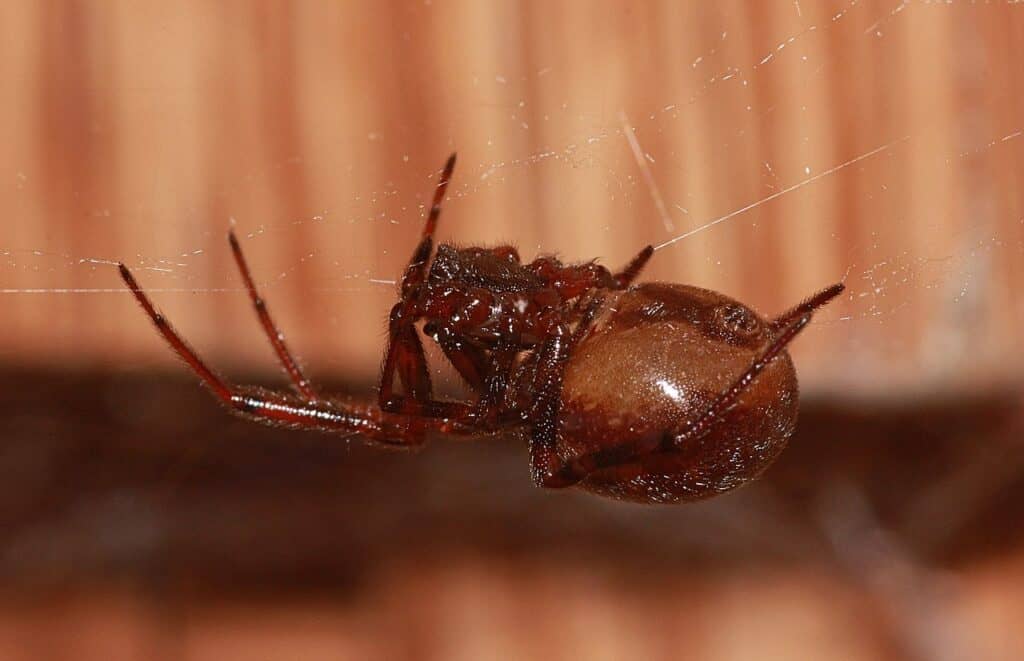
The northern cupboard spider often gets confused for the more dangerous black widow spider.
©Paul Harrison / Creative Commons – License
Steatoda borealis, or the northern cupboard spider, is the second member of the family Theridiidae to make our list of spiders in Rhode Island. You may also know it by its other common name, the boreal combfoot spider. This spider ranges throughout much of the northern United States and Canada.
On average, adult northern cupboard spiders measure 7 millimeters long. However, females usually measure larger than males. They look glossy dark brown or black and sport a light T-shaped marking near the front of the abdomen. People often confuse them for black widow spiders, which is why they also go by the name false widows.
Northern cupboard spiders make irregularly-shaped webs that they use to catch their prey. Given their poor eyesight, they rely on sensing vibrations to determine when prey falls into their webs. Although their bite is not dangerous to humans, it can cause mild pain, redness, and swelling.
#4. Red-Spotted Ant Mimic
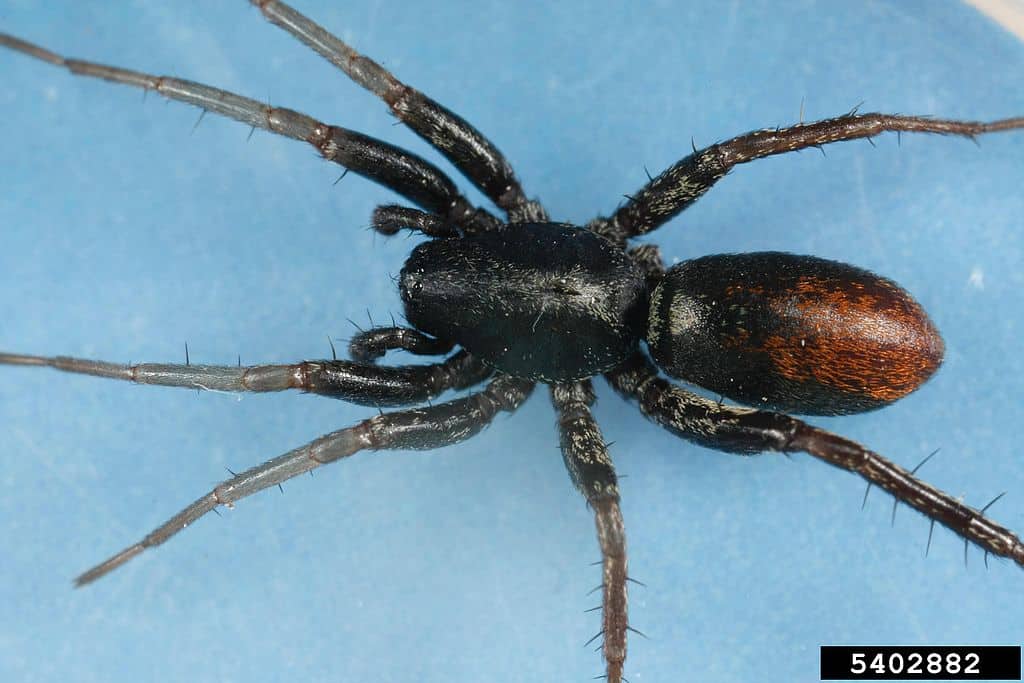
The red-spotted ant mimic acts like an ant in order to sneak up on its prey.
©Joseph Berger, Bugwood.org; University of Georgia / CC BY 3.0, via Wikimedia Commons – License
Castianeria descripta, or the red-spotted ant mimic, belongs to the corrinid spider family Corinnidae. You can find it throughout much of the United States, particularly in shrubs or wooded areas located near anthills.
Adult females average around 13 millimeters long, while males measure slightly smaller on average. Their body appears almost uniformly black aside from a reddish-brown marking on the abdomen. People sometimes mistake them for black widows due to their similar size and shape. However, unlike black widows, these spiders feature a faint white line running down the center of the carapace.
Red-spotted ant mimics utilize one of the most unique prey-capture methods of all the spiders in Rhode Island. Instead of using webs, they mimic the appearance of ants by using their front two legs like antennae. This allows them to get close enough to ambush their prey. Their bite is not medically significant.
#3. Carolina Wolf Spider
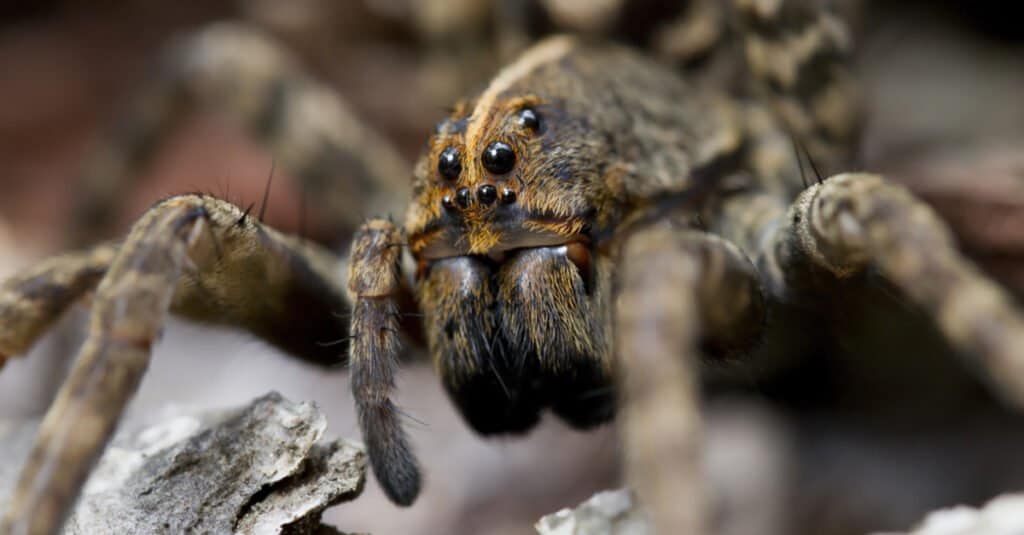
The forest wolf spider can reach nearly 50 millimeters long with its legs extended.
©Will E. Davis/Shutterstock.com
The Carolina wolf spider, Hogna carolinensis, belongs to the wolf spider family Lycosidae. It is the largest wolf spider in North America and one of the largest spiders in Rhode Island.
Adult females typically measure between 22 and 35 millimeters long. Meanwhile, males average 18 to 20 millimeters long. They usually look light brown, except for some dark brown markings on the abdomen and orange color on the sides. Their eyes reflect light exceptionally well, and you can often spot the females carrying their egg sacs on top of the spinneret during the breeding season.
Carolina wolf spiders do not use webs to capture prey. Instead, they dig burrows in the ground and then ambush unsuspecting prey that wanders too close. On rare occasions, they will also wander around in search of prey. Their venom simultaneously paralyzes and disinfects their food. Despite their size, their bite is not medically significant.
#2. Cave Orb Weaver
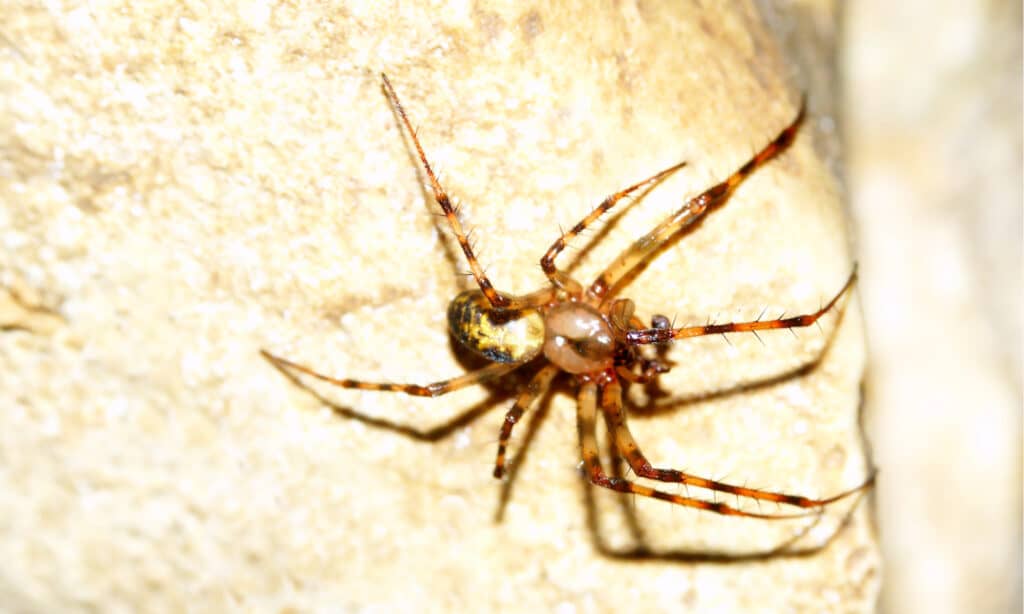
Cave orb weavers live in caves and tunnels devoid of light.
©Jason Patrick Ross/Shutterstock.com
Meta menardi, or the cave orb weaver, belongs to the long-jawed orb weaver family Tetragnathidae. It also goes by the name, the European cave spider or simply the cave spider. You can find it throughout Europe and parts of East Asia and North America.
Adult females measure from 8 to 10 millimeters long, while males measure somewhat smaller. Unlike other members of the Tetragnahtidae family, cave orb weavers lack long jaws, legs, and bodies. Their body typically appears dark brown, and they feature white and dark markings on their abdomen. Additionally, they sport light and dark brown bands on their legs.
Cave orb weavers are one of the most unusual spiders in Rhode Island. They are photophobic, so they live in places with no or low light. They make vertical webs in tunnels and caves, hence their name. Also, their bite is not medically significant.
#1. Brown Recluse
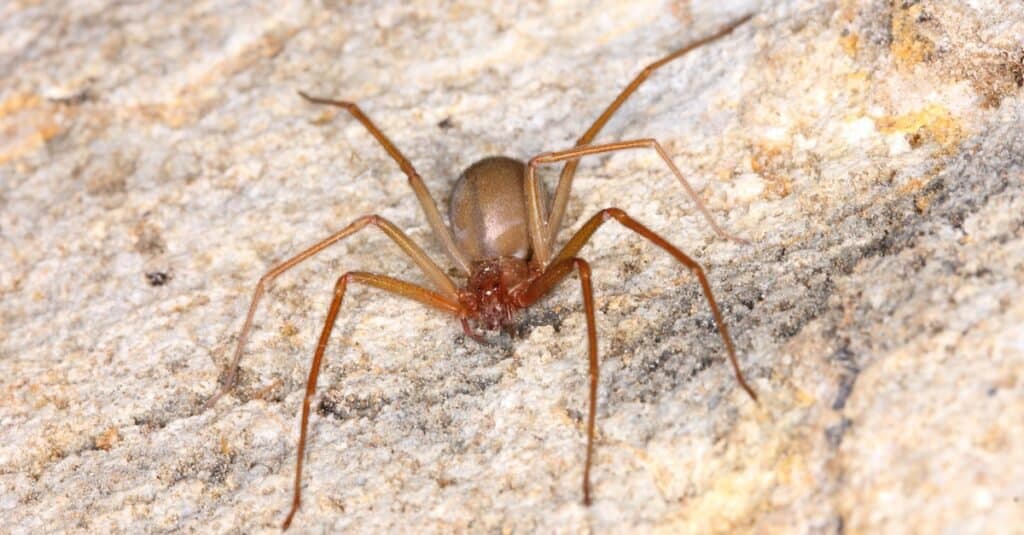
The brown recluse spider is one of the most dangerous spiders in the United States.
©Pong Wira/Shutterstock.com
The brown recluse, Loxosceles reclusa, is one of the most poisonous spiders in Rhode Island. It belongs to the family Sicariidae, a family of about 160 species with most of its members possessing necrotic venom. You can find it throughout most of North America.
Adult brown recluses measure between 6 and 20 millimeters in length, with males measuring smaller than females. Their body ranges in color from light to dark brown or grey. They feature a dark line on their cephalothorax in the shape of a violin. This marking is the reason why some people call them fiddleback spiders, brown fiddlers, or violin spiders.
Brown recluses tend to live in secluded, dark places, hence their name. They build irregular webs but don’t use their webs to catch prey. Instead, they actively hunt other insects and invertebrates at night. Their bite carries necrotic venom that can cause vomiting, muscle aches, and skin necrosis.
Summary Of 10 Spiders In Rhode Island
| Rank | Spider |
|---|---|
| 10 | Giant Lichen Orb Weaver |
| 9 | Huntsman Spider |
| 8 | Eastern Parson Spider |
| 7 | Candy-Striped Spider |
| 6 | Daring Jumping Spider |
| 5 | Northern Cupboard Spider |
| 4 | Red-Spotted Ant Mimic |
| 3 | Carolina Wolf Spider |
| 2 | Cave Orb Weaver |
| 1 | Brown Recluse |
The photo featured at the top of this post is © Physics_joe/Shutterstock.com
Thank you for reading! Have some feedback for us? Contact the AZ Animals editorial team.






